Researchers Demonstrate Self-Powered Cardiac Pacemaker
June 24, 2014
A research team headed by Keon Jae Lee, PhD, of the Department of Materials Science and Engineering at the Korea Advanced Institute of Science and Technology (KAIST), and Boyoung Joung, MD, of the Division of Cardiology at Severance Hospital of Yonsei University, has developed a self-powered artificial cardiac pacemaker that is semi-permanently operated by a flexible piezoelectric nanogenerator.
|
A self-powered cardiac pacemaker powered by a flexible piezoelectric energy harvester (Courtesy KAIST) |
Current-technology pacemakers have a power supply whose lifespan is limited to about seven years. This necessitates the repeated replacement of the battery, with the consequent risks of repeated surgeries. The nanogenerator is intended to reduce, if not eliminate, this need for repeated surgeries merely to replace depleted batteries.
The team's accomplishment has been documented in "Self-Powered Cardiac Pacemaker Enabled by Flexible Single Crystalline PMN-PT Piezoelectric Energy Harvester" (Hwang, et al.), in the journal Advanced Materials.
The flexible piezoelectric nanogenerator directly stimulated a living rat's heart using electrical energy converted from the small body movements of the rat. The team says this technology could facilitate the use of self-powered flexible energy harvesters, not only prolonging the lifetime of cardiac pacemakers but also realizing real-time heart monitoring.
The research team fabricated high-performance flexible nanogenerators utilizing a bulk single-crystal PMN-PT thin film. The harvested energy reached up to 8.2 V and 0.22 mA from the natural bending and pushing motions of the rat, which were high enough values to directly stimulate the rat's heart, as well as to directly charge commercial batteries.
In a statement announcing the publication, Lee said, "For clinical purposes, the current achievement will benefit the development of self-powered cardiac pacemakers as well as prevent heart attacks via the real-time diagnosis of heart arrhythmia. In addition, the flexible piezoelectric nanogenerator could also be utilized as an electrical source for various implantable medical devices."
Stephen Levy is a contributor to Qmed and MPMN.
About the Author(s)
You May Also Like


.png?width=300&auto=webp&quality=80&disable=upscale)
